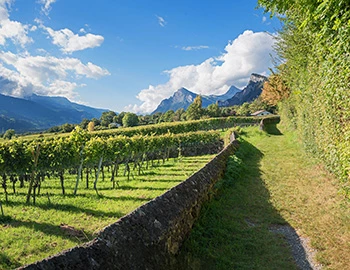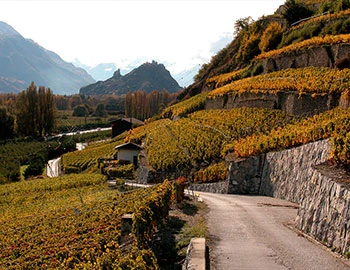1844 Ballenz weiss 2023
Ostschweizer Landwein, Roland und Karin Lenz, 750 ml

| Grape variety: | Sauvignac, Rheinriesling |
| Producer: | Roland und Karin Lenz |
| Origin: | Switzerland / Ostschweiz |
Description
A fascinating cuvée that conjures up the radiant sunshine of Eastern Switzerland directly in your glass! The bouquet seduces with an exotic flavour reminiscent of passion fruit and citrus fruits, accompanied by a delicate note of blossoming orange blossom. The very first sip delights with its lively freshness and juicy fruitiness. The palate is enveloped by a harmonious interplay of sweetness and acidity that ends in a subtly salty finish. Perfect as an aperitif wine and ideal with (Swiss) tapas or a colourful salad.
Attributes
| Origin: | Switzerland / Ostschweiz |
| Grape variety: | Sauvignac, Rheinriesling |
| Label: | Vegan, Certified organic or biodynamic wine |
| Ripening potential: | 1 to 3 years |
| Drinking temperature: | 10 to 12 °C |
| Food Pairing: | Apéro riche, Asparagus specialities, Fresh water fish with cream sauce, Crispy roast chicken |
| Vinification: | pressed carefully and immediately |
| Harvest: | hand-picking |
| Maturation: | in steel tank |
| Volume: | 10.0 % |
| Note: | Contains sulphites |
Roland und Karin Lenz
In 1994, while Roland Lenz was still studying oenology, he and his wife Karin were able to acquire eight hectares of vines on the Iselisberg. It was a unique opportunity that they seized, even though they were toying with the idea of setting up their own business abroad, far from Switzerland. They actually did so later, but that's another story…
It is only in the last two decades that the Canton of Thurgau has really come to the attention of wine lovers as a wine-growing area. Its apple orchards and the apple juice (must) pressed from the picked fruit have always been popular, inevitably earning the canton its nickname of «Must India». Viticulture, however, has existed in this region for centuries.

Ostschweiz
Eastern Switzerland: an intriguing puzzle
Eastern Switzerland has long been positioned on the northern rim of the climate zone where the cultivation of popular Swiss varieties is possible. Due to a warming climate, the vineyards of Aargau, Zurich, Schaffhausen, Thurgau and Graubünden are now in the zone where varieties such as Müller-Thurgau or Pinot Noir succeed excellently. But even long-established, almost-forgotten varieties such as Elbling, Räuschling and Completer are experiencing a renaissance.

Switzerland
Switzerland – A small country with enormous diversity
Switzerland is famous for its banks, watches, and cheese, but not necessarily for its wine. The Swiss didn't invent wine, but they have been extremely open and curious to it. Wine culture arrived in what is now modern Switzerland via several routes: from Marseilles to Lake Geneva and the Lower Valais region; from the Aosta Valley through the Great St. Bernard Pass to the rest of Valais; from the Rhone through Burgundy, across the Jura Mountains to Lake Constance; and from Lombardy to Ticino, and then on to Grisons.



